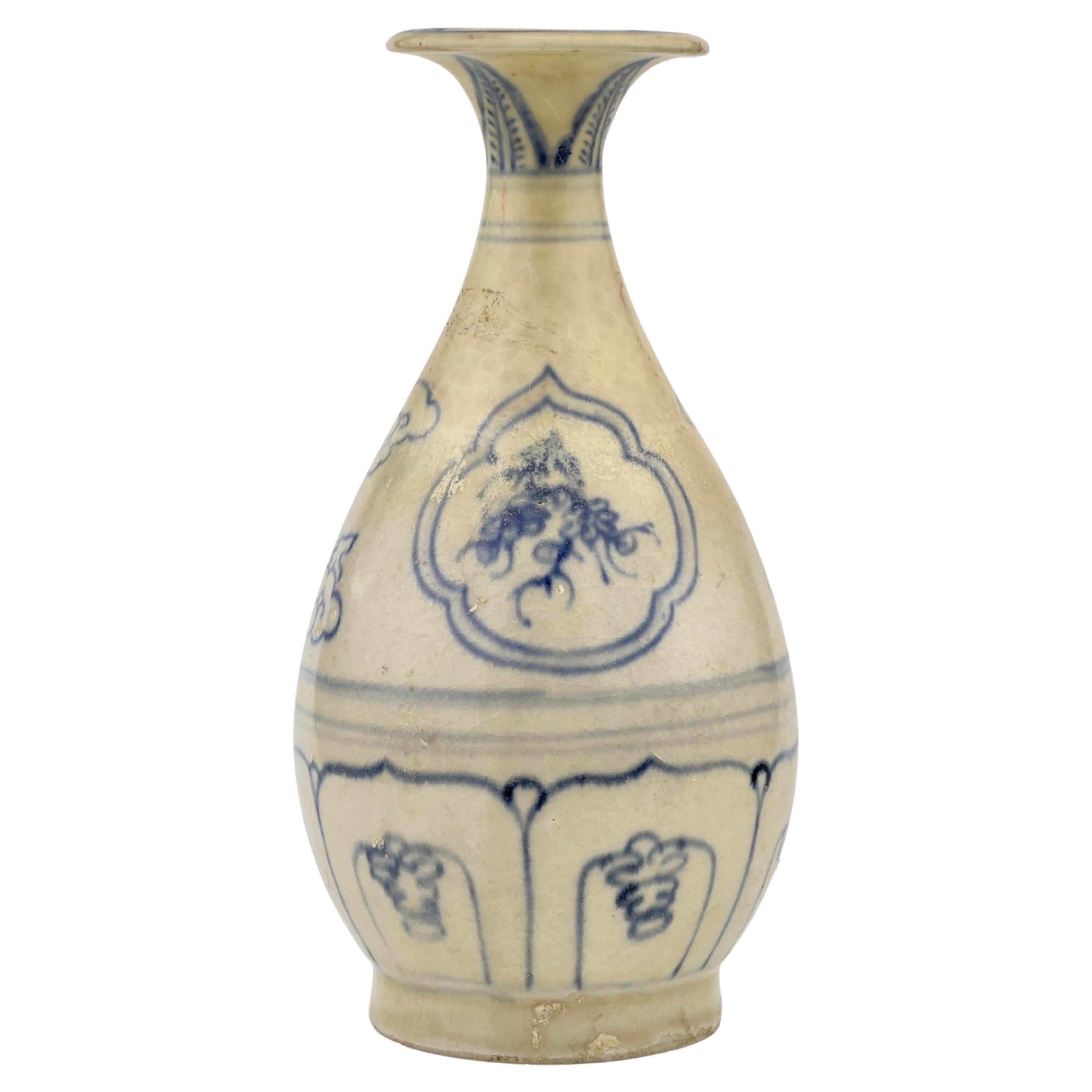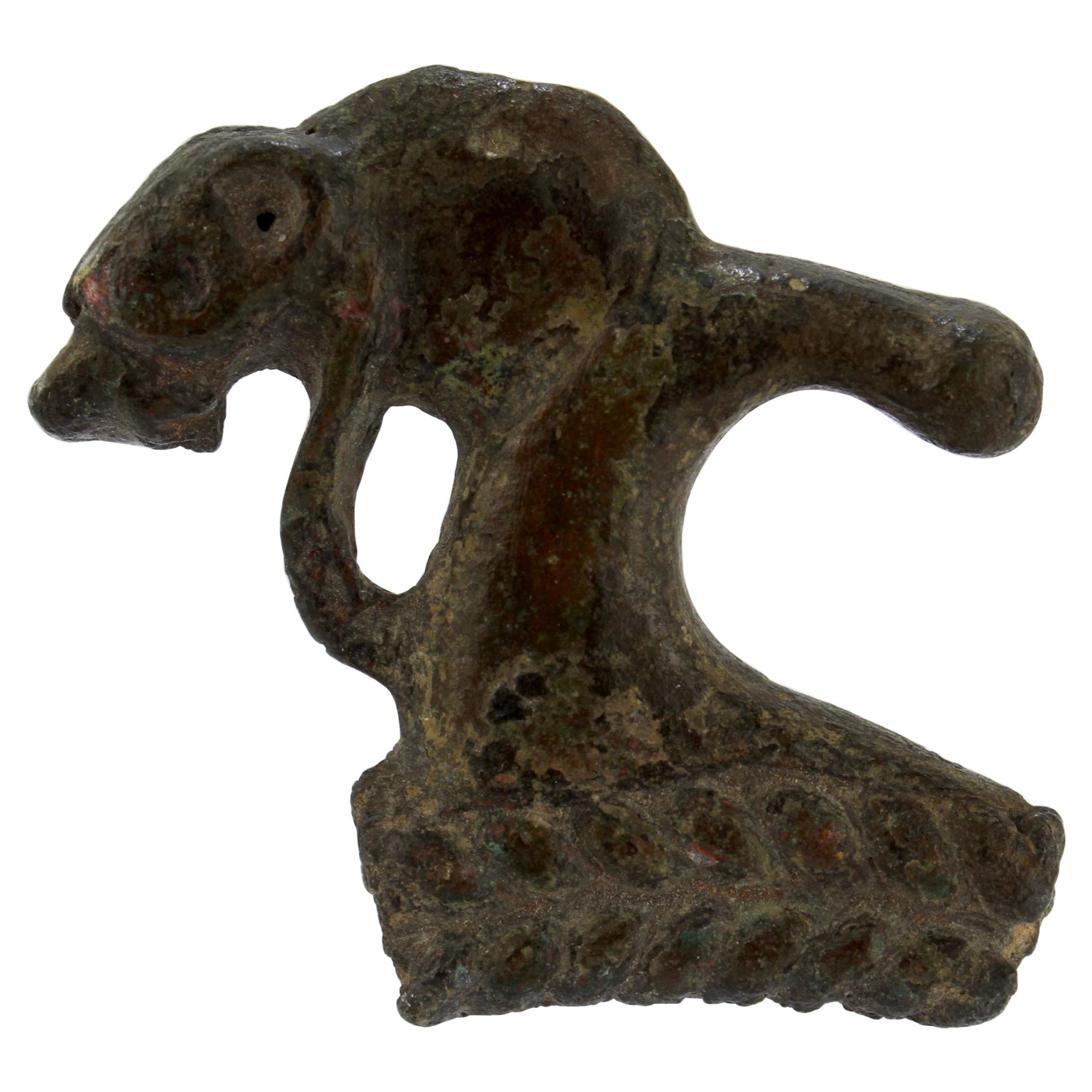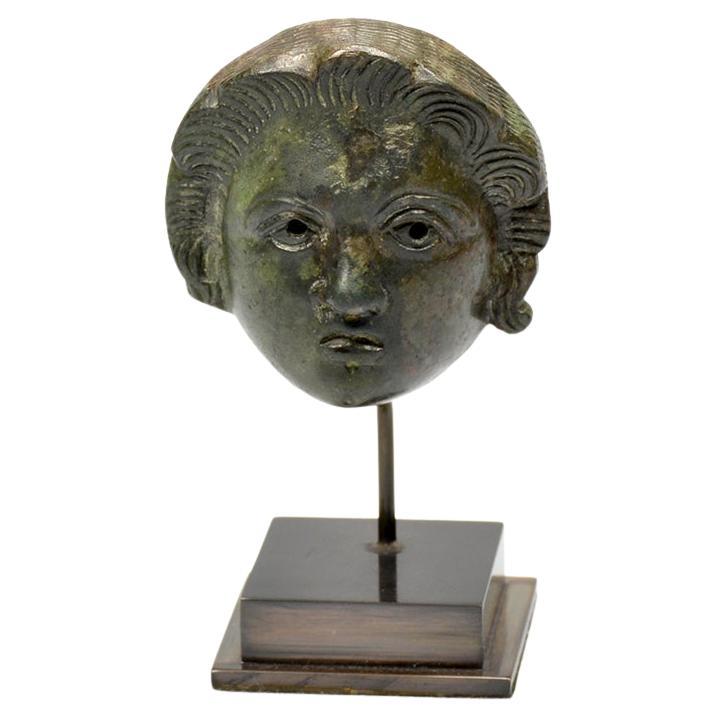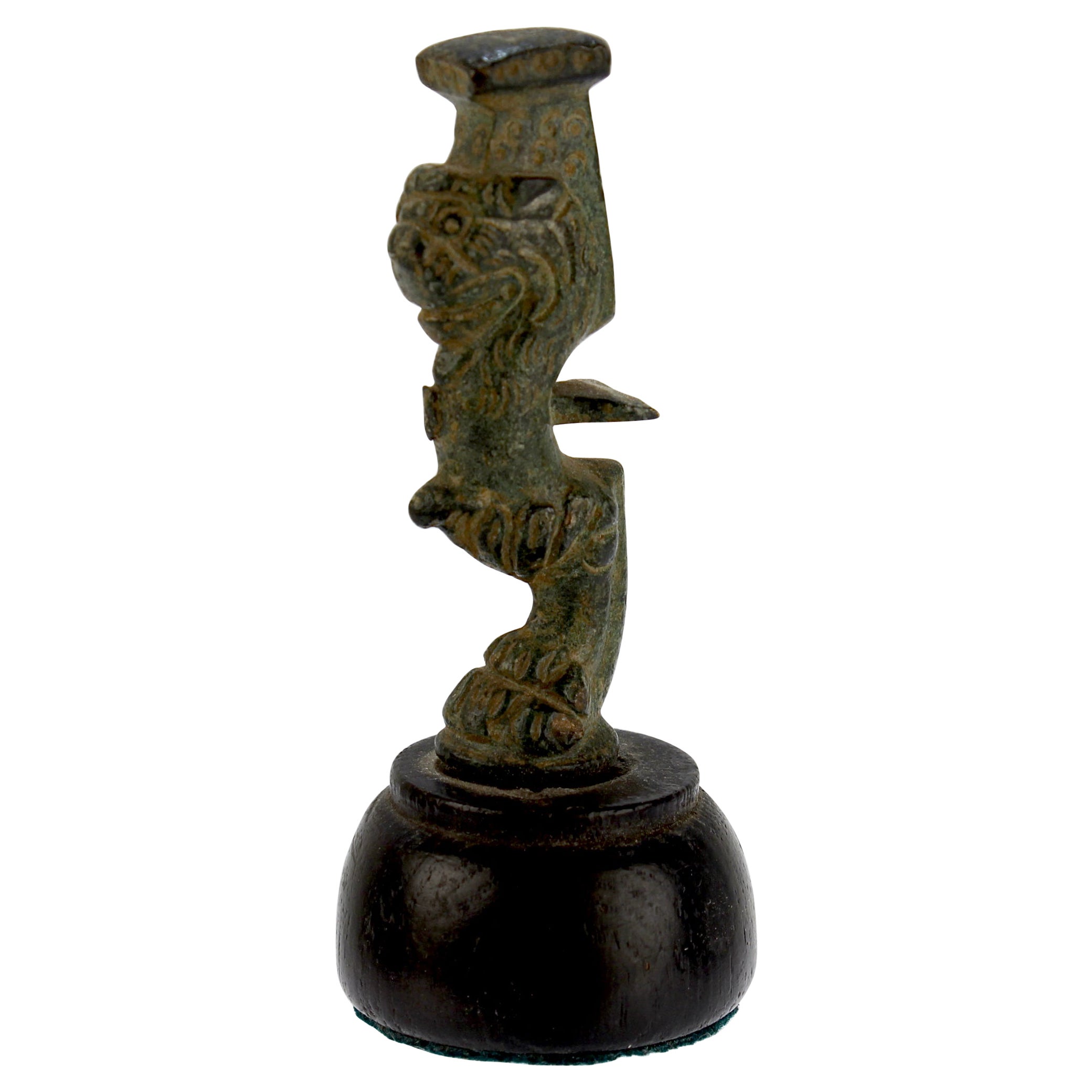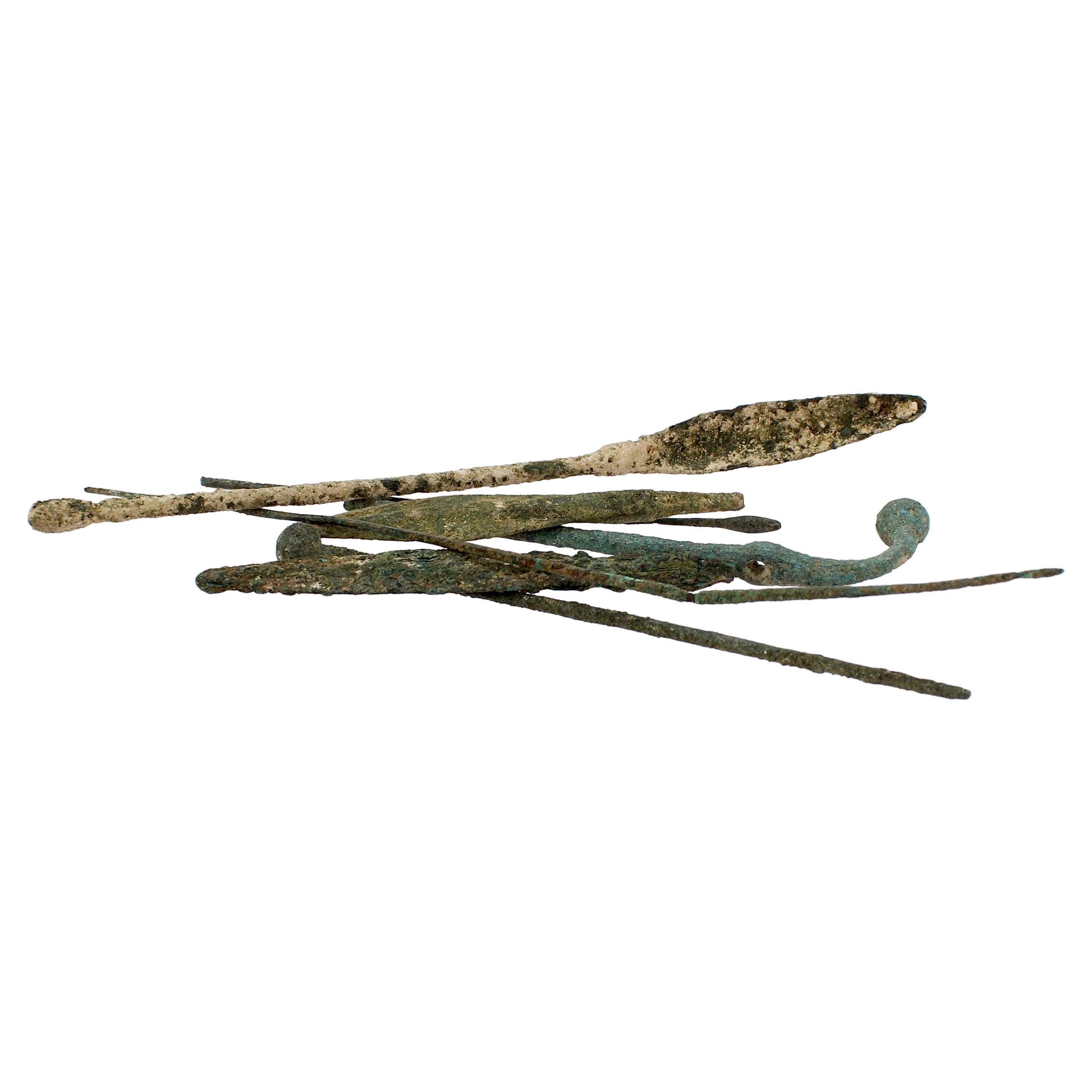Want more images or videos?
Request additional images or videos from the seller
1 of 8
Bronze Hoard
About the Item
Dagger L: 27.8 cm,
Luniform bronze, possibly a belt buckle L: 10.8 cm,
Shield-shaped bronze with a point Diam: 6.5 cm,
Pommel Diam: 3.7 cm,
Violin-bow brooch L: 17.5 cm,
P-Shaped bow brooch L: 9 cm,
Bow brooch L: 3.5 cm,
Ring 1 Diam: 7.7 cm, Ring 2 Diam: 4.8 cm, Ring 3 Diam: 3.7 cm
A collection of unique bronzes found together on the bed of the Gravona river in the French territorial collectivity of Corsica, during the construction of the Ajaccio-Bastia railway line, which first opened in 1888. This provides two possible precise locations for the find, at the two points where bridges were constructed for the line to cross the river: either in Carbuccia, 10 km north-east of Ajaccio, or at Bocognano, 10 km further in the same direction along the valley. This discovery was published in 1924, in an 8-page essay in the bulletin of the Société Préhistorique Française by Dr Robert Forrer, the director of the Musée préhistorique et gallo-romain in Strasbourg.
Various reasons for the discovery of this group in one place have been suggested. It may have been part of a funerary hoard, or perhaps several burials along the banks of the Gravona, a trader’s wares, or even the hidden treasure of a warrior. Both potential discovery sites are in inland mountainous regions. Forrer posits that the bronzes were brought in from Sardinia, via Ajaccio and up the river, and were the property of a Sherden warrior. However, recent research indicates that the Torrean civilisation in the south of Corsica – previously thought to have begun in the second millennium BCE when Sherden warriors landed on the island – was in fact an indigenous population. There is at least one confirmed example of the distinctive megalithic towers (torri) built by this civilisation in the Gravona valley, north-east of the capital. Therefore, these bronzes may have been produced near the discovery site.
The group contains: a dagger; a luniform bronze that may have been a belt-buckle; a pommel; a disc with a projecting spike, which may have been part of a horses harness or brooch; three bow fibula of various sizes; and three simple rings of differing sizes, possibly a form of proto-currency. The style of these objects suggests a burial date of around 900 BCE.
The dagger is in the style of swords of the late Bronze Age, featuring a leaf-shaped blade with a raised medial rib down its length. The blade and hilt appear to have been cast as one. The hilt joins the blade via a raised semi-circle, and is adorned with five raised round rivets.
The crescent-shaped object features five similar rivets along the arc, and a pointed hook on the reverse. A short cross with rounded ends extends from the inner centre of the arc. The rivets and hook could have served as a means of affixing the bronze in place, suggesting that this object may have been a belt-buckle, or perhaps part of a scabbard or horse harness.
The circular disc features a large rounded spike projecting from its centre, recalling the shields held by warriors in Nuragic bronze statues. Small holes are pierced around the circumference, four of which contain chain links, suggesting that this disc was previously part of a larger object. The disc may have been a phalera on a horse harness or perhaps the centrepiece of a brooch, as in a contemporaneous example in the Metropolitan Museum of Art, New York (2007.498.2).
The pommel takes the form of a hollow ovoid, pierced longitudinally with a hole about 1.3-1.4 cm in dia meter, and with another very small hole through one side. This would allow a stick to be inserted through the pommel and held in place by a small nail, so that the pommel could be wielded as a part of a sceptre or other weapon. However, at only 69 g, it seems most likely that this pommel served a decorative, rather than a martial, function.
This collection contains three brooches, including one of remarkable size. The largest brooch is of the typical violin-bow form, with a long pin and spiral coil. The broad catchplate is adorned with raised points of hammered decoration, with a few horizontal lines incised on the bar connecting the plate to the spiral. The median-sized P-shaped brooch, now missing its pin, features an incised pattern of a cross across the arch. Three thin rings attached in a chain at the foot of the brooch suggest an additional ornament of some kind was originally affixed here. The smallest brooch curves towards a pronounced raised rib in the centre of the bow.
Each of the three rings in this find are formed from a single bronze rod, bent into its circular shape. The largest is made from a cylindrical rod, while the others are each formed from a rhomboid rod. It is unlikely that these would have been bracelets, as their diameters are too small. Forrer proposed that, due to their simple forms and the relationship between each of their weights (the weight of the smallest is about 2/3 of the second smallest, which is approximately 1/4 of the largest), these rings may have been a form of currency, of the kind found in other Bronze Age settlements in Europe.
Published:
R Forrer, ‘Un trésor de bronzes préhistoriques decouvert en Corse’, Bulletin de la Société préhistorique de France, 10, 1924, pp. 224-232.
Provenance:
Discovered c. 1880-90 near Ajaccio, Corsica.
Private Collection of Mr Ducasse.
Thence by descent to Jean Dimitri Ducasse (b. 1883), Sarrebourg.
Thence by descent.
ALR: S00228228, with IADAA Certificate, this item has been checked against the Interpol database.
- Dimensions:Height: 10.95 in (27.8 cm)Width: 4.22 in (10.7 cm)Depth: 1.38 in (3.5 cm)
- Sold As:Set of 10
- Style:Classical Roman (Of the Period)
- Materials and Techniques:
- Place of Origin:
- Period:
- Date of Manufacture:circa 900 B.C
- Condition:Wear consistent with age and use.
- Seller Location:London, GB
- Reference Number:
About the Seller
5.0
Vetted Seller
These experienced sellers undergo a comprehensive evaluation by our team of in-house experts.
Established in 1910
1stDibs seller since 2020
- ShippingRetrieving quote...Ships From: London, United Kingdom
- Return PolicyThis item cannot be returned.
More From This SellerView All
- Bronze SirenLocated in London, GBSirens were dangerous bird-like females who tempted sailors with their hauntingly beautiful song. In Homer’s Odyssey (XII, 39) Odysseus and his sailors were warned about the lethal c...Category
Antique 15th Century and Earlier Greek Classical Greek Antiquities
MaterialsBronze
- Anglo-Saxon Hanging BowlLocated in London, GBA very rare and near-complete copper-alloy hanging bowl and associated fittings. Crafted from a single sheet of bronze, the body of the bowl is curved, with a slightly recessed lip. ...Category
Antique 15th Century and Earlier English Antiquities
MaterialsBronze
- Two Glass Inlay PairsLocated in London, GBTwo pairs of two halves from the same bar, finely detailed, with pointed ears and eyebrows, opaque yellow face, opaque red on the mouth, nose, eyes and ears, translucent cobalt blue edges to the mouth, nose and ears, with translucent emerald green leaves above and between the translucent cobalt blue brows and eye line, translucent pink pupils, with translucent cobalt blie and opaque white snake scales below the face, in translucent cobalt blue matrix, cut in the lower part of a cartouche design. These rare heads might represent the Agathos Daimon, the tutelary deity of Alexandria, who was also identified with Serapis, the male counterpart of Isis-Thermouthis (who in turn was a graecisized form of the early snake harvest goddess Renenutet). In a statue of Isis-Thermouthis in Alexandria museum (no. 25773, ex-collection King Farouk I), reproduced in Gotten, Pharaonen, no. 151, the snake goddess...Category
Antique 15th Century and Earlier Egyptian Antiquities
MaterialsGlass
- Statuette of the Goddess NeithLocated in London, GBBronze statue of the goddess Neith, striding, her left foot extended forward. Her left hand is extended forward and formally held a papyrus sceptre, a fragmentary ankh is visible in ...Category
Antique 15th Century and Earlier Egyptian Egyptian Antiquities
MaterialsBronze
- Megalithic StelaLocated in London, GBA tall anthropomorphic stele of carved granite, divided into two distinct regions of the body and face. The body is a single unarticulated block, but the facial features are outlined...Category
Antique 15th Century and Earlier European Antiquities
MaterialsGranite
- Ushabti for ImenmesLocated in London, GBA mummiform ushabti in blue faience. Four registers of hieroglyphic characters are painted around the lower half of the ushabti, with a vertical column of hieroglyphs in the centre o...Category
Antique 15th Century and Earlier Egyptian Egyptian Antiquities
MaterialsFaience
You May Also Like
- Annamese stoneware with underglaze blue, Hoi An hoard, late 15th centuryLocated in seoul, KRDecorated with floral and foliate reserves and clouds; lappets at base and leaves at neck. Dates : 15th century Le Dynasty Region : North Annam Type : Yuhuchun Vase Found/Acquired : Southeast Asia , South China Sea, Hoi An Ship Reference : 1) Art Gallery of Greater Victoria - A vase from the wreck of the Hoi An 2) Butterfield Treasures Hoi An Hoard...Category
Antique 15th Century and Earlier Chinese Ming Antiquities
MaterialsStoneware
- A Roman bronze footLocated in UTRECHT, UTWith square fitting, hollow at the top for attachment to furniture, one large paw on round base sprouting into lion’s head with visible teeth. 9,5 cm (h) Ex German private property...Category
Antique 15th Century and Earlier Italian Classical Roman Antiquities
MaterialsBronze
- Ancient Roman Bronze Handle or ArtifactLocated in Philadelphia, PAAn antique or ancient Roman bronze element. This piece was an element of a vase or possibly handle to something larger. It has the head of...Category
Antique 15th Century and Earlier European Classical Roman Antiquities
MaterialsBronze
- A Roman bronze head attachment of a youthLocated in UTRECHT, UTA finely detailed appliqué with the face of a youth, wavy hair framing the circular face, with well defined eyes, pierced for inlays. 5.5 cm (h) Provenance: Ex Jean-Phillipe Mari...Category
Antique 15th Century and Earlier Italian Classical Roman Antiquities
MaterialsBronze
- Ancient Roman Bronze Leg or Artifact / ElementLocated in Philadelphia, PAA fine Ancient Roman bronze element. It appears to be a leg or support for a larger structure. The leg has a hoofed foot that supports a li...Category
Antique 15th Century and Earlier European Classical Roman Antiquities
MaterialsBronze
- Ancient Roman Bronze Crossbow Fibula or Toga PinLocated in Philadelphia, PAA fine ancient Roman bronze fibula. A so-called crossbow fibula. From the private collection of Lawrence Majewski, who was a former conservator at the Metropolitan Museum of Ar...Category
Antique 15th Century and Earlier European Classical Roman Antiquities
MaterialsBronze
